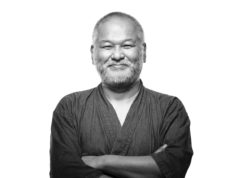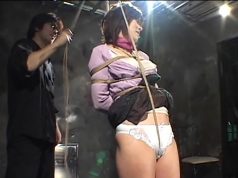Sin is an expat Englishman resident in Munich with long standing business ties in Japan. After an enforced 10-year vanilla hiatus he took up SM rope-play again in 2012, becoming a student of Bingo Shigonawa san. He is a regular performer, but shies away from photography or video.
Zetsu: What brought you into the world of Kinbaku?
Sin: I had sado-erotic fantasies since the onset of puberty. At 14 I rented soft porn magazines to my fellow schoolmates. Pre-digital, I trained as an advertising-fashion photographer in West London. Studio staff used to have private film-nights: 8mm of amateur hardcore and classic British sexual innuendo. I did a few spanking and early shaving shoots for a publisher in Wardour Street. The darkroom was a library of international hardcore when certain material, considered common today, was risky to be caught in possession. Because it was illegal, it harbored very unsavory elements. It was my first exposure to BDSM, the first time I saw rope bondage. My first wife introduced me to BDSM proper in the 80’s via a copy of Histoire d’O, but I wasn’t really mature enough. It took me until my 40’s to realise that not all ladies sought the chivalry of the prince come to rescue them, that some indeed crave the black knight to come and take them. Back then there was no Internet, no scene, and draconian obscenity laws, so we kept it secret. We enjoyed our version of rope-play. I had no knowledge of Kinbaku, but what we did had distinct similarities. After the relationship ended, I had a Japanese girlfriend. She was the first to show me Kinbaku.
Zetsu: You have some impressive connections to Japanese Bakushi. Can you explain how you know these people, and your relationship with them?
 Sin: I was in a doomed second marriage, and missed BDSM and rope-play. I was traveling frequently to Japan on business, and far from home the craving got the better of me. I walked into a bar in Roppongi where two dominatrices were providing for a male submissive using rope. I still couldn’t communicate in Japanese, so my secret excursions were careful and anonymous. I had a heart attack in 2010. I had to change my lifestyle, physically, mentally and emotionally. My motto became ‘Life is a game we all lose. Play The Game’. With this new philosophy coincided intense work in Japan. My increasing nocturnal activities led, by chance to Yoi Yoshida san and I attended one of her superb Ōnawa asobi events. Within 2-days I came to know many of Japan’s current top Bakushi. My jaw hit the floor when I saw what these people were doing, and as they kindly befriended me I knew in my heart I had found like-minded people on my wavelength: right place at the right time – a fortunate accident. My relationship is friend and compatriot within our common subterranean existence.
Sin: I was in a doomed second marriage, and missed BDSM and rope-play. I was traveling frequently to Japan on business, and far from home the craving got the better of me. I walked into a bar in Roppongi where two dominatrices were providing for a male submissive using rope. I still couldn’t communicate in Japanese, so my secret excursions were careful and anonymous. I had a heart attack in 2010. I had to change my lifestyle, physically, mentally and emotionally. My motto became ‘Life is a game we all lose. Play The Game’. With this new philosophy coincided intense work in Japan. My increasing nocturnal activities led, by chance to Yoi Yoshida san and I attended one of her superb Ōnawa asobi events. Within 2-days I came to know many of Japan’s current top Bakushi. My jaw hit the floor when I saw what these people were doing, and as they kindly befriended me I knew in my heart I had found like-minded people on my wavelength: right place at the right time – a fortunate accident. My relationship is friend and compatriot within our common subterranean existence.
Zetsu: How did you become the student of Bingo Shigonawa san?
Sin: I’m not sure I’m comfortable with the word Student, although Bingo san says that he’s happy with it. You regularly hear the words Sensei and Deshi. In my humble opinion it doesn’t work quite like that. What Sensei was Takashi Tsujimura san the Deshi of? Akechi Denki san? Chimuo Nureki san? I wonder what they’d think if they could see us with our gaijin interpretations. My ethos is that you must stand or fall on your own name. Bingo san is my friend, a great guy who’s shown me techniques he’s either adapted or developed. I adore his level of creativity. He also gave me the dignified propriety of behaviour, etiquette and reason. I was kindly attended by Nawanojyoh san at my first Nawakai, and bedazzled by Nagare Aotsuki san, Ero Ouji san and Bingo san. Travel to Osaka made asking the former impractical, so I approached Ero Ouji san. He doesn’t teach and suggested Bingo san. I asked. He agreed. Now I’m part of the eternal loop: Bakushi learning and absorbing from other Bakushi, as it always has been, either directly, watching performances, or picking it up from magazines. Bingo san is not exclusive, and a very good 1-on-1 teacher of his own Ryū – safety, etiquette, culture, well-positioned creative Shibari and its purpose within Kinbaku sado-masochism. I’d recommend him to anybody.
Zetsu: How would you describe your style?
Sin: My style is my own. How could it not be? I am provider, and see my task as identifying precisely the wishes and capabilities of my rope partner and then expanding her boundaries via clear communication and consent. Women love attention: having their hair styled, nails manicured, a good massage. I do this in a dominant sado-erotic sense using rope, psychology, and without the threat of sexual advances. My ladies often come to me stressed, and leave relaxed and happy, and this is my interpretation of a successful Bakushi practicing satisfying Kinbaku. They return on a weekly basis, so I must be doing something right, and their opinion of my rope outweighs anybody’s. They joke I am their rope therapist, and we enjoy what we do. There are situations when only the rope should touch the lady, so I minimize contact, and others she desires me to go deeper. Proper communication, observance and understanding signals are imperative. It sounds easy, but many do not have the psyche to fully master and never advance beyond the rigging. It takes a specific mentality. I tie securely, not tightly. I dominate quietly, dirty whispers, and administer Matanawa, whips, and floods of hot wax. I observe, and develop methods to pick up what is, and more importantly, what isn’t working, where she wants to be taken, and where she does not. I build mental, emotional and physical maps of my rope partner and focus in detail, patiently, progressing carefully. I can’t know her finite condition on any particular day. I don’t know exactly how I feel about what I’m doing until I’m into session. I push gently on the metaphoric buttons to find which produce good and bad results, and focus only on what is working. My philosophy is BDSM is a higher form of love, not a lower form of abuse, and if I have to give a name to what I do I’d call it Kan’nō nawa – sensual/erotic/carnal rope. But it goes beyond language, Japanese/English. In a nutshell, it isn’t really about rope, even though rope is being used. It is Essence, and Kinbaku has subtleties that allow this to blossom beyond the Shibari.
Zetsu: Who are your influences?
Sin: Definitely Bingo san. He’s taught me some great Shibari, but also things I find missing in The West. The inspirational Nagare Aotsuki san – the first time I saw him was an epiphany. It was like looking into the mirror of my soul. I knew where I was from that moment. I adore Ero Ouji san, and I suppose Akechi Denki san, because he had such an influence on my influences: his humility, encouragement, philosophy, creativity and humanity. I never had the chance to meet him, but when you talk to people who did, he comes across as a positive guy, in spite of his physical ailments.
Zetsu: You always use the word Bakushi. Do you see any difference between this and Rigger?
Sin: If you put 100 rope users together you’ll get 100 opinions. But yes, it helps me to make my own demarcations based on my particular understanding. Like English, Japanese can be interpreted in so many ways, and we’re all guilty of trying to pigeonhole what cannot be put in a box. It’s mindsets, not nationalities or languages. I think of Kinbaku as BDSM where Shibari is used, and not a martial art. Kinbaku is a relatively new word, but there’s Shunga art depicting erotic rope-play dating back centuries. Rope was used to tie people for various reasons, and at some point the authoritarian use became formalized. I struggle to enjoy the zealous following of Torinawa and Budō Hojōjutsu militaristic practices because I don’t aspire to be a policeman or jailer. The quality of my Asanawa is sacred, but if your mindset is tying a criminal, I suppose the rope quality isn’t relevant. When I tie, I want her to feel the sensuality in the rope. I’ve seen events where rope ‘bunnies’ are challenged to escape, but I’m not tying Houdini. They have to desire a deeply enjoyable experience in the rope that will elevate them through restraint, shame, pain, sensations, pleasure, release, purification, and ultimately fulfillment. I’m not practicing outdated, brutal and cruel penal binding methods, but sexual gratification via sado-masochism using rope. I find it far more satisfying to tie in a natural way to the evolving situation than to parrot rigid cataloged judicial Shibari patterns. I’m happy with what I do, and respect how others enjoy rope.
Zetsu: You shy away from teaching, workshops, photography and video.
Sin: Bingo san encouraged me to develop my own style, ties and philosophy – to follow my own path, to be different. I don’t teach, but I always encourage. It would be presumptuous to think I can be a teacher. I believe Kinbaku has to be demonstrated for it to be understood, and I’m more comfortable performing. I never felt the urge to be an authority. I don’t attend workshops because they don’t work for me. I prefer the intimacy and focus of absorbing 1-on-1. Kinbaku isn’t really a group thing. Online rope photography occasionally inspires me, but I’m reluctant to make images of my rope because it detracts from its essence. I don’t seek the perfect tie, but the rope that will bring fulfillment, so understanding what is required weighs greater than the finite position of a knot. My best Kinbaku is in private, Ipponnawa. When I perform we intend making the audience horny, and live Kinbaku brings a deeper satisfaction to my exhibitionist models. You can’t capture that feeling. Images could never do this justice. Concentrating on the aesthetic detracts from the feel and the raison d’etre, and besides, Kinbaku as performance art is one of the last bastions against the hoards of smartphone camera wielding audiences – photography is strictly forbidden. But, you can closely voyeur the experience to absorb the wider elements of Kinbaku beyond the mere visual. You have to be a part of it and hold it in your memory. I concede there may be a time where photography may be required. That’s a path I’m still not sure I wish to follow. I kind of agree with the late Akechi Denki san that Kinbaku is probably best kept underground.
Zetsu: Can you describe to our readers a typical performance?
Sin: I train with 3 gorgeous models, and have another in Tokyo. We are close friends. Each has things she can’t do, wants to try, and creative input. We meticulously practice based around what may look dangerously impossible and terrifically sadistic, but actually work for us comfortably, and is choreographed to tease emotions, and demonstrate what pleasure can be rewarded via Kinbaku. We enjoy what we’re doing as a team. At a specific rope-play event you have the luxury of an audience that understands, technically. Most performances are at fetish events where the audience is easily bored by the tying/untying. To hold their attention I tie with minimum rope and focus on the DS & SM elements, captivating them like a magician, going through transitions to bring my model to climax within the telling of an erotic story: soft, slow and romantic to frantic hardcore, with surprises. I suppose it’s a cross between rigging, theatre and sado-eroticism, but a performance is never just a performance. There’s a realism you only witness by attendance and focus. When we perform, there are no illusions.
Zetsu: How would you say that Japanese Bakushi view the western scene?
Sin: My honest opinion is the Japanese are too polite to give their views freely, and themselves often miss the finer details of the way we do things. Gaijin can be just as baffling to a Japanese. I’m lucky to work for a company with strong ties to Japan. We absorb culture in small doses, and have to overcome our mother-culture to observe with greater neutrality. The more you know: language, writing, history, psychology, ethos, etiquette, Etc., the better you understand. I get the impression they sometimes think we add western reason to translation, over-interpret, and let the minutia pass un-noticed.
Zetsu: Are there Bakushi largely unknown outside of Japan that you would recommend?
Sin: Ero Ouji san and Bingo Shigonawa san are starting to be known, so I’d suggest Nagare Aotsuki san and Nawanojyoh san. Shima Malphas san, and his development of gothic horror Kinbaku shows fascinate me. I’d like to meet him to discuss our approaches to performance development. Historically, we gaijin have looked into Japanese rope-play through an extremely narrow window, and there are so many actively practicing Kinbaku that you could go to any event in Japan and unearth a revelation. In the dominatrix clubs there are undoubtedly phenomenal female Bakushi that we will never see on a stage, most practicing on paying male submissives. Japan may be conservative, but their historical resistance to, especially religious repression, has seen their taboos develop differently. The Japanese have a unique view about guilt and pain: purification and release. Shiatsu massage is painful, releases tensions, and lets you relax. Bakushi are demonstrating another kaihō in rope-play that along with other cultural traditions were inhibited by the occupying GHQ/SCAP and forced underground for decades.
Zetsu: You mentioned the importance of the rope. Do you have any advice regarding rope type and preparation techniques?
Sin: Your rope can say a lot about your style, care, and approach. I recommend developing your own way by experimentation. I’ve done many things to rope: waxes, oils, scents and dyes, polishing, tensioning. I use high-quality ø6mm Japanese jute Asanawa, because it is the best for the job. Be careful of the type and content of batching oil. I like a 2-ply laid yarn with a medium-loose twist. I use different rope for Matanawa. As far as preparation goes, I’ll always be experimenting. I boil Aranawa and dry under weighted tension, flame the hairs, clean the soot with sake, apply beeswax and jojoba oil, and finally coat with Bayū. It feels like silk. Rope is alive, and when you have put the patience in to produce a set with so much of yourself in it, it takes on a spirit and works with you when you do Kinbaku, transmitting your domination, resonance and desire.
Zetsu: What advice would you give to anybody starting out in rope?
Sin: It should go without saying your rope partner’s safety is Priority #1. Be mature enough to know you will make mistakes. When it happens you must act immediately for their safety, and not continue for your own hubris. Why you want to be involved with rope, to experience pleasure with a like-minded partner? Be careful what you learn, there are awful injury reports about individuals that have set themselves up in business to teach. If you’re starting out, pick up the Shibari basics from books and the Internet. Find a rope-loving partner that wants to learn with you. Learn the anatomy and dangers, take it slowly, and don’t proceed to suspensions. Kinbaku is wonderful on the floor. Suspension adds a level of complexity that should only be tackled after the fundamental items are understood. Listen to your rope partner. Encourage them to understand the warnings and communicate quickly and accurately. The instant they report a problem, stop everything and get them out of the rope. Analyze the problem together. This will build trust and respect, and they’ll be enthusiastic for more. Practice constantly, find your own path, never stop learning, remain humble, and ignore rivalry, vested interests and petty politics. When you feel competent, and have understood what the rope and the tying/untying gives to your partner, seek somebody with a good reputation who has a style you like, and invest in 1-to-1 tuition. There is no hierarchy, and just because you are a beginner does not mean that you are not of the same grass. If your passion and understanding is equal then you are too. Concentration, comprehension and practice make real ability.
Zetsu: Is there any area that you would like to explore or improve?
Sin: I’d like to promote a more consensual approach to Kinbaku, where mutual satisfaction for both bottom and top come from better understanding, where injuries decline through better information and education, and where the Shibari is better for its function and reason. There are so many elements that need to connect: desires, psyche, physique, ability, observance, understanding, arousal, emotions, and ability.







